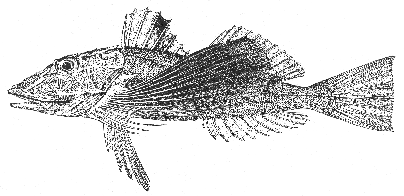Striped sea robin Prionotus evolans (Linnaeus) 1766
[Jordan and Evermann, 1896-1900, p. 2167, as Prionotus strigatus Cuvier and Valenciennes, 1829[69]]

Figure 246.—Striped sea robin (Prionotus evolans), Woods Hole, Mass. From Goode. Drawing by H. L. Todd.
Description—
The striped sea robin resembles the common sea robin so closely that one might easily be taken for the other. But its mouth is wider and gapes back almost opposite the front of the eye, with the maxillary bone more than one-third as long as the head. Its head is flatter (compare fig. 246 with fig. 245); its pectoral fins are longer relatively (reaching back to the ninth or tenth ray of the soft dorsal fin instead of only to the fifth or sixth ray); its pectoral feelers are more slender and tapering; its caudal fin is square-ended instead of concave in rear outline; and its reddish or olive-brown sides (the general ground tint varies) are marked longitudinally with a dusky or bronze-brown stripe below the lateral line. The first dorsal fin shows the same black or dusky blotch between the fourth and fifth spines, so characteristic of the common robin. The pectorals are orange to brown with pale edges, their centers washed with dusky, but without the definite crossbars characteristic of the common sea robin. The pectoral filaments are pale brown or orange, marked with narrow brown bars. (The common sea robin does not show these bars.)
Size—
This is a larger fish than the common sea robin, growing to a maximum length of about 18 inches.
General range—
Shoal water along the Atlantic coast of North America from South Carolina to Cape Cod, reaching the Gulf of Maine as a stray from the south.
Occurrence in the Gulf of Maine—
This southern fish rounds Cape Cod so seldom that there are only 6 definite records for it from the Gulf of Maine: Monomoy; North Truro; Salem; Gloucester; Monhegan Island, Maine (its most northerly outpost) where one was taken in an otter trawl at 40 fathoms, November 19, 1933; and the eastern part of Georges Bank, whence one was brought in to the U. S. Fish Commission sometime between 1877 and 1880. We have never seen it north or east of the elbow of Cape Cod.
[69] Ginsberg (Texas Jour. Sci., vol. 2, No, 4, 1950, p. 519, 520-522) has shown that the P. strigatus of Cuvier and Valenciennes is not separable from the evolans of Linnaeus.